5 Reasons Trekkies Should Respect Star Trek: The Motion Picture
Trekkies don't tend to look all that favorably at the very first Star Trek movie, Star Trek: The Motion Picture. The general consensus is that it is one of the worst of the eleven movies to date, and even I listed it as such in a previous post. It's a slow, long-winded movie (one of it's derogatory monikers is "Star Trek: The Slow-Motion Picture") that tries too hard to be something other than what it is. However, upon rewatching it this weekend, I noticed that the movie contains the first appearance of many of Star Trek's most beloved ideas and character templates, albeit in primordial form. In addition to the theme song for Star Trek: The Next Generation, it is quite possible that, without Star Trek: The Motion Picture, we wouldn't have the following:
STAR TREK IV: THE VOYAGE HOME
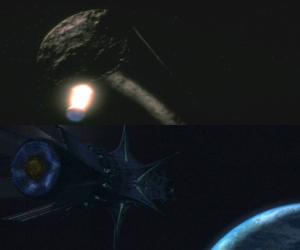 | | One wants to talk to God, the other wants to talk to whales; you decide which one is better |
Star Trek IV: The Voyage Home is considered the most successful of the original Star Trek movies, with box office profits that are hard to argue against. The set-up is as follows: an enigmatic alien craft is headed for Earth, destroying anything that gets in its way. As it threatens the very heart of Starfleet, it is up to Admiral Kirk and his crew to discover the hidden rationale for the craft's arrival and prevent it from destroying all life on Earth.
Incidentally, that is also, word-for-word, the set-up for Star Trek: The Motion Picture. Indeed, if you simplify it to just "an alien craft threatens Earth and only the Enterprise crew can stop it," that would apply to Star Trek: The Motion Picture, Star Trek: First Contact, Star Trek: Nemesis, and 2009's Star Trek, along with a couple of episodes of TNG and an entire season of Star Trek: Enterprise. You could argue that putting Earth in danger is an inevitable narrative conceit, but I don't think Trekkies really considered what it would be like until Star Trek: The Motion Picture. Star Trek IV did it better, as evidenced by the aforementioned box office, but The Motion Picture did it first.
RIKER & TROI
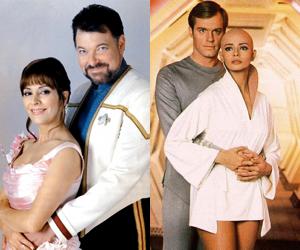 | | TNG has more hair than TMP |
I'm no shipper, but one of the most interesting relationships in Star Trek history is the relationship between Riker and Troi from Star Trek: The Next Generation. In the pilot episode, "Encounter at Farpoint," we learn that the two of them have a history, that Commander Riker--the second in command of the Enterprise who is more than qualified to captain his own vessel--was previously stationed on the alien homeworld of Counsellor Troi, a new member of the Enterprise crew with strange psychic abilities. They apparently had a relationship that ended abruptly when Riker left without saying goodbye.
Throughout the show's run, including the films, Riker and Troi's on-again-off-again relationship grows warmer and warmer until they get married at the start of Star Trek: Nemesis. Though there are several other romantic entanglements in Star Trek's long canon, it is Riker and Troi's romance that is the most memorable and engaging.
Their story starts, though, in exactly the same way as the story of Commander Decker and Lieutenant Ilia. The moment Decker and Ilia first interact onscreen is almost identical to the first onscreen interaction between Riker and Troi. Once Ilia enters the bridge and shares a meaningful moment with Commander Decker, we quickly learn that the two of them have a history, that Decker--the second in command of the Enterprise who is more than qualified to captain his own vessel--was previously stationed on Ilia's alien homeworld and left without saying goodbye. Also, Ilia has strange psychic abilities.
Granted, the story of Decker and Ilia doesn't end as happily as Riker and Troi's--Ilia is unceremoniously vaporized by V'Ger and Decker then decides to join with the mechanical lifeform--but it's fair to say that their story set the stage for Riker and Troi in TNG. It's even plausible that Decker and Ilia's story was originally designed to be as long-lasting as Riker and Troi's, as the script for Star Trek: The Motion Picture was adapted from the script for a pilot episode of Star Trek: Phase II, which was to be the second Star Trek television series.
THE BORG
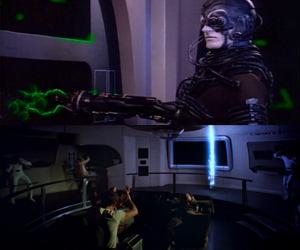 | | The lesson learned: if an alien wants to read your databanks, just let it |
Quite possibly the coolest idea to come out of Star Trek: The Next Generation is the concept of the Borg, a cybernetic race from the other side of the galaxy hell-bent on relentlessly assimilating everything in their path without the slightest hint of compassion or remorse. They even have an ominous catch-phrase: "resistance is futile." Some fans, including this one, credit the Borg with helping TNG break free of the shackles of the original series, as it seemed to be a wholly original concept that would be hard to imagine existing in the universe of Captain Kirk's Enterprise.
There are several memorable moments involving the Borg in TNG. When the Enterprise crew first encounters them, for example, the Borg send over a single intruder--a "probe"--to gather information on the Enterprise, seemingly oblivious to the existence of the ship's crew. When somebody attempts to get in the way, the intruder attacks, but then continues its work. Several episodes later, the Borg capture Captain Picard and assimilate him into a Borg named Locutus. While onboard the Enterprise, Locutus is calm and unaggressive, coldly observing those around him while explaining very matter-of-factly that they will all soon be assimilated. Later, our heroes manage to change the Borg by letting them assimilate a person with a sense of individuality.
In Star Trek: The Motion Picture, we learn of a race of mechanical lifeforms from the far side of the galaxy who captured an old Voyager-class probe and repurposed it with their technology to fulfill its mission of learning all it can learn. When the Enterprise encounters it--now calling itself "V'Ger"--it sends a single "probe" of its own to invade and study the ship. This probe ignores the crew until someone attempts to interfere, at which point it attacks and then continues its work. V'Ger then "uploads" Lieutenant Ilia as a "data unit" and returns her to the ship as another probe. Once onboard, Ilia is calm and unaggressive, coldly observing those around her while explaining very matter-of-factly that all the "carbon-based units" on the ship will be taken by V'Ger and repurposed into "data units" like her. At one point, Spock explains that V'Ger is so powerful that "any resistance would be futile." In the end, our heroes only succeed in stopping V'Ger's plan by letting it "join with" Commander Decker, thereby giving it a sense of humanity.
These similarities have absolutely been noticed by Trekkies before me. Even Gene Roddenberry has theorized that there is a connection between the mechanical race that assimilated Voyager-6 and the Borg, though no connection has been made clear in the canonical Star Trek universe. The bottom line, however, is that the Borg may not be a wholly unique idea in Star Trek. On some level, even if it was in Rick Berman's subconscious, the Borg owes its existence to ideas first explored in Star Trek: The Motion Picture.
STAR TREK: VOYAGER
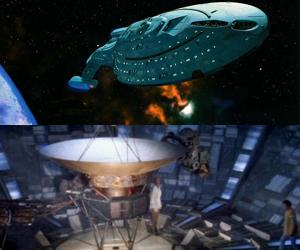 | | All V'Ger needed was a plucky holographic doctor |
After two shows that dealt with the Enterprise exploring the Alpha Quadrant and one show that dealt with a space station sitting at the gateway to the Gamma Quadrant, the fourth Star Trek television series needed a new hook. Enter Star Trek: Voyager, in which a spacecraft named Voyager slips through a spacetime anomaly and finds itself in the Delta Quadrant, which is on the far side of the galaxy. Voyager then has to trek all the way back to Earth, all the while seeing strange new worlds and encountering new lifeforms, which the crew diligently records so that people back home can study it all.
Though the series is easily my least favorite of all five (no, I'm not counting the animated series), even I admit it is a great premise for a Star Trek adventure. Instead of going over familiar ground with Klingons and Romulans and such, the very idea of Star Trek: Voyager forced the writers to come up with brand new ideas (although they often fell back on the Borg). When the series first debuted, I thought it was a brilliantly original idea with plenty of promise.
You know where this is going. The main antagonist in Star Trek: The Motion Picture is V'Ger, which as it turns out is a spacecraft named Voyager. Voyager slipped through a spacetime anomaly and was sent to the opposite end of the galaxy before beginning its long journey home. It recorded everything it encountered along its way so that its creator (humanity) could study it all. I'd be more than willing to consider this a coincidence if it weren't for the fact that the 24th Century vessel is called Voyager. Seriously, the only way they could have made it any more obvious is if crewmembers occasionally referred to their ship by the nickname "V'Ger."
STAR TREK (2009)
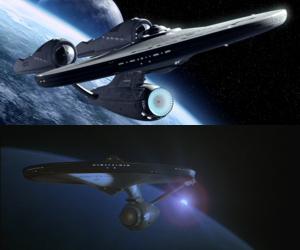 | | Just look at that lens flare! |
Every time I watch Star Trek: The Motion Picture, I try to imagine what it must have been like for Trekkies in 1979. The original series only lasted three seasons, and it had been several long years since its unceremonious cancellation. Therefore, when it was announced that there'd be a Star Trek movie, it had to have been ridiculously exciting, especially in the days before practically every property gets a television show, a movie, a book, a video game, and an officially-licensed handbag. Star Trek: The Motion Picture was an event, one of the most expensive and heavily marketed movies of its day, and the filmmakers took it very seriously.
This was the first time anybody got to see Star Trek with a big budget, so they spared no expense in making it epic. For the first time, audiences got to see things like Starfleet Command in San Francisco teeming with people and aliens, aliens who really looked like aliens (especially the Klingons), the Enterprise in all its glory leaving an orbital spacedock over Earth, and so much more. Things as simple as the transporter effects and Starfleet uniforms were reimagined for the big screen, and it was several orders of magnitude more professional-looking than anything the schlocky television show had managed. In modern terms, Star Trek: The Motion Picture was a reboot for the franchise.
A couple of years ago, I finally got a sense of the feelings it must have inspired in 1979 audiences, because 2009's Star Trek took a similar approach to the property. Though the movie has its fair share of flaws, you cannot argue that 2009's Star Trek is anything but epic. Again, everything was reimagined from scratch, and audiences got to see things they'd never before seen in Star Trek. The reimagined Klingons may have ended up on the cutting room floor (thankfully, if we are to go by the deleted scenes), but the other aliens in the film look more convincingly alien than ever, and overall, the visual and special effects are an enormous leap forward. On top of that, everything is bigger, from the number of people onboard to the size of Starfleet itself, and every scene reminds the audience that this is a much grander universe than we've come to expect. In a very real sense, therefore, 2009's Star Trek is a spiritual counterpart to 1979's Star Trek: The Motion Picture. If you are not convinced of this, just listen to the reboot's director, J.J. Abrams, who says in an audio commentary track that he wanted the reveal of the Enterprise in his film, in which the ship leaves an orbital spacedock over Earth, to be an homage to Star Trek: The Motion Picture.
I'm not trying to argue that there is no originality left in the Star Trek universe, nor am I trying to argue that, because it did many things first, Star Trek: The Motion Picture is better than everything that followed it. On the contrary, I am trying to remind Trekkies that what we love about Star Trek is there even in the places we tend to overlook. Though I still consider it one of the lesser films in the franchise, I do believe that Star Trek: The Motion Picture doesn't always get the recognition it deserves. If you want to see where Star Trek is headed in the future, you might just find a hint or two where Star Trek has boldly gone before.
-e. magill 7/19/2011
|
|